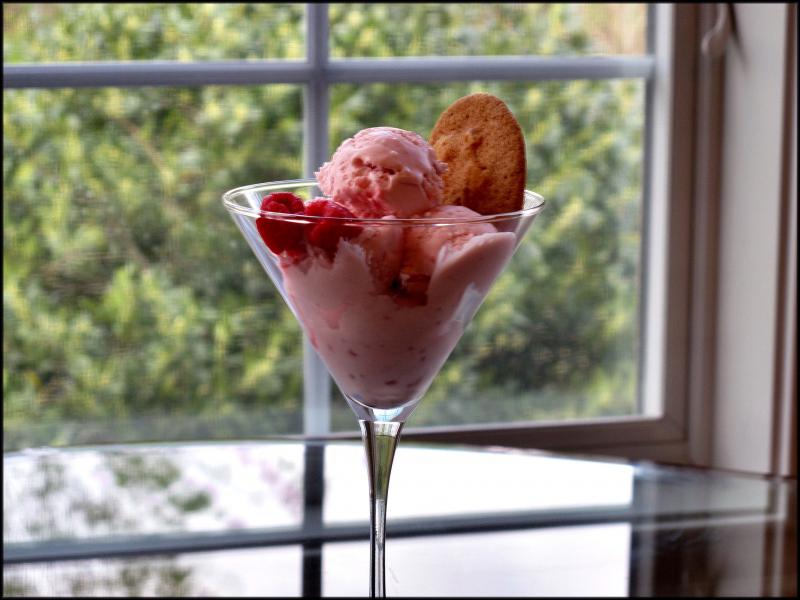Transform basic ice cream into delicate treat
Looking at photos posted on various social media platforms, you can see what most people are doing while staying home under the current coronavirus quarantine: Baking – everything from breads and cakes to scones and cookies. Some folks consulted neglected cookbooks to make elaborate meals or demonstrated their creativity and culinary skills by sharing innovative ingredient substitutions.
Since we were well-stocked with bread (sourdough boule and cranberry walnut loaf from Old World Breads) and a nice supply of English muffins and Tate’s ginger cookies from Lloyd’s, instead of baking or taking pictures of our meals, I decided to use a pint of frozen raspberries to transform basic vanilla ice cream into a delicate pink treat.
According to food historians, ice cream’s origins can be traced to China in the second century BC. Notable figures such as Alexander the Great and Nero Claudius Caesar harvested mountain snow to flavor with honey and fruit. Marco Polo is credited with bringing the idea of iced dessert back to Europe with a dish that more closely resembled what we know today as sorbet.
Eventually, frozen water flavored with fruit juices evolved into “cream ice” which was served by European monarchs and royalty including Charles I, Catherine de Medici and Henry II. The addition of eggs to the cream mixture is reported to have been introduced in the Cafe Procope in Paris in the 17th century. Citizens of the newly formed United States followed the examples set by George Washington, Thomas Jefferson and Dolley Madison in their enjoyment of ice cream.
In the decades that followed, improvements in manufacturing, refrigeration and distribution supported wider production and availability of the frozen treat. When we call something ice cream, we are typically referring to an egg and cream custard that is first heated and then frozen. Sorbet is made with water and fruit juice, while sherbet has a dairy component. Gelato is made with less cream and is lower in fat; it also incorporates less air and doesn’t call for the addition of eggs.
When you search for an ice cream recipe, you’ll find they vary widely in specifications for the number of egg yolks (never the whole egg). For the raspberry version in the photo, we opted to omit the eggs entirely, to allow the delicate fruit flavor to shine. Although many non-egg recipes have you heat the milk and cream, this step is unnecessary if the dairy products are already pasteurized.
For rich, creamy ice cream (especially with strong flavors like chocolate or mint), plan to use between 4 and 6 egg yolks. For these recipes, the heating step is non-negotiable, as you need to make sure the egg mixture reaches a temperature of 170 F. You’ll want to use the tempering technique when combining the hot cream and cold yolks, so as not to cook the eggs, but incorporate them slowly into the hot milk.
With the sophistication of modern ice cream makers, you no longer have to pack a wooden bucket with rock salt and crank a handle for (what always seemed like) hours. Most have a container that is placed in the freezer until the material in the walls is frozen. It’s then filled with the custard and placed on the base to automatically churn with a fitted paddle.
I’ve included two recipes, one for the simple raspberry delight and another for a richer vanilla-flavored base that is perfect for your favorite stir-ins. When storing the ice cream, be sure to tightly cover the surface with plastic wrap to prevent ice crystals from forming, although we ate this batch so quickly, that was never a problem.
Raspberry Ice Cream
1 pint raspberries
1/2 C sugar
1 t vanilla
1/2 C whole milk
1 1/2 C heavy cream
Combine raspberries, sugar and vanilla in the bowl of a food processor and pulse until the berries are crushed, about 2 or 3 times. Transfer mixture to a bowl; cover and refrigerate for 1 hour. Strain the mixture through a fine sieve or food mill to extract all the juices into a bowl; discard the seeds. Add the milk and cream to the fruit juice; stir to combine. Pour the mixture into the container of an ice cream maker and churn according to the manufacturer’s instructions. In our basic Cuisinart ice cream maker, the process took less than 30 minutes. Yield: 1 quart.
Vanilla Ice Cream
2 C heavy cream
1 C whole milk
2/3 C sugar
pinch salt
6 egg yolks
Combine the cream, milk, sugar and salt in a saucepan. Bring to a simmer over medium, stirring until the sugar dissolves, about 4 minutes. Remove the pot from the heat. In a bowl, whisk the egg yolks until smooth and golden. While continuously whisking, slowly add 1 C of the heated cream to the egg yolks. Still whisking, pour the yolk mixture into the saucepan with the remaining cream. Return the pan to medium-low heat and cook slowly until the mixture reaches 170 F. Strain the mixture through a fine sieve into a bowl. Cover and refrigerate for at least 4 hours before churning in your ice cream maker according to the manufacturer’s instructions. Yield: 1 1/2 pints.






















































